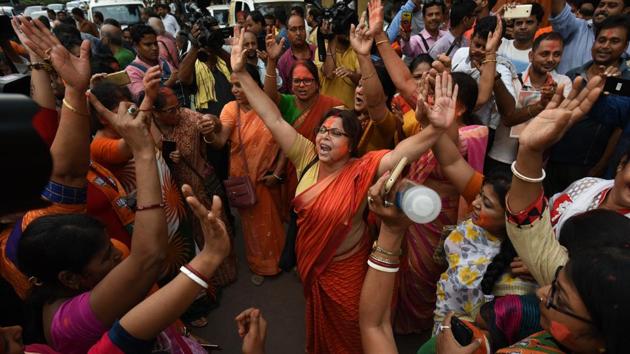From Marx to Modi: How Left voters ensured BJP’s Bengal victory
The BJP’s performance in Bengal was fuelled by the vote bank that had earlier powered the Communist Party of India (Marxist) and its partners for more than three decades.
Election results in Bengal have made it clear that the biggest contribution to Bharatiya Janata Party’s astounding performance in the state came from the vote bank that had earlier powered the Communist Party of India (Marxist) and its partners for more than three decades.

Out of 40 Left candidates in the race, 39 forfeited their deposits as they failed to secure one sixth of the votes cast in their respective seats. The direct beneficiary was BJP.
“All over Bengal, Left votes went to BJP. CPI(M) workers were asked to vote for the saffron. It is no secret. The two parties had an understanding,” said Trinamool Congress’ Dum Dum candidate Saugata Roy who won the seat for the third time.
Roy got 42.51 % votes with BJP’s Samik Bhattacharya trailing with 38.1 % and CPI(M)’s Nepaldeb Bhattacharya finishing third with 13.9 %. The fact that the CPI(M) got 15.08 % less than its score in 2014 and BJP got 15.61 % more than what it achieved that year vindicated Roy’s claim.
There were similar figures from all over Bengal, including those seats where BJP did not win. At the so-called TMC stronghold in Kanthi (East Midnapore), for example, two-time TMC MP Sisir Adhikari got 50 % votes but BJP’s Debasish Samanta secured 42% while CPI(M)’s Paritosh Pattanayak ended third with 5.3 %. In 2014 and 2009, Adhikari won the Kanthi seat but CPI(M) came second with 34.72 % and 42.5 % respectively. It was apparent that bulk of the votes that went to CPI(M) in the past has gone to BJP this year.
From Malda district to Cooch Behar, BJP painted north Bengal saffron, winning seven out of eight seats by securing votes that went not just to CPI(M) but also to Revolutionary Socialist Party (RSP) and Forward Bloc in 2014.
In Alipurduar, for example, BJP’s John Barla won with 54.4 % votes, TMC’s Dasrath Tirkey got 36.7% and RSP’s Mili Oraon came third with 3.9 %. In 2014, RSP came second with 27.72 % votes.
“BJP won so many seats because of religious polarisation. Left’s vote share in the state remains around 8%,” said CPI(M) state secretariat member and Siliguri mayor Ashok Bhattacharya.
“The Left contributed to BJP’s victory in north Bengal. But this will not be the picture in the 2021 assembly election,” said tourism minister Gautam Deb.
In Kolkata, where BJP could not score, TMC’s Mala Roy won the Kolkata South seat with 47.5 % votes, securing a rise of 10.55 % over 2014. BJP’s Chandra Kumar Bose came second with 34.64%, a rise by 9.36% over 2014. CPI(M) candidate, Nandini Mukherjee, came third with 11.63%, marking a drop by 12.17 % since 2014.
Sarthak Roychowdhury, professor of economics and political commentator said, “CPI(M) workers relentlessly asked for support from the leadership in the districts and villages but were left in a void. They were desperate to save their existence and exercise their minimum rights. They got that support from BJP.”
“In urban areas, middle class and upper middle class Hindu voters silently supported BJP because religion is an important issue for them. Also, people did not like the way opposition leaders badmouthed Narendra Modi and called him thief,” Roychowdhury added.
Bengal BJP president Dilip Ghosh said the saffron party was the underdog which got the people’s support.
“BJP contested in Bengal with whatever resources it had at its disposal and had to put up with stiff resistance from the ruling party at every step. People appreciated our struggle,” said Ghosh.
“This is the result of competitive communalism by BJP and TMC. We have to analyse the results and form a new national and state-level strategy” said CPI(M) state secretary Surya Kanta Mishra.
In the 2009 Lok Sabha elections, which was the first electoral confirmation of votes swinging away from the Marxists, the Left Front secured 43.3% votes but won only 15 seats. In comparison, 19 seats went to Trinamool Congress although the party had a far lower vote share of 31.18%. That year, BJP got only 6.14% votes and one seat in Bengal.
The saffron camp’s vote share in the 2014 Lok Sabha polls rose to 17.02% when it won two seats from the state, the highest it ever had until the 18 seats it won this time.




